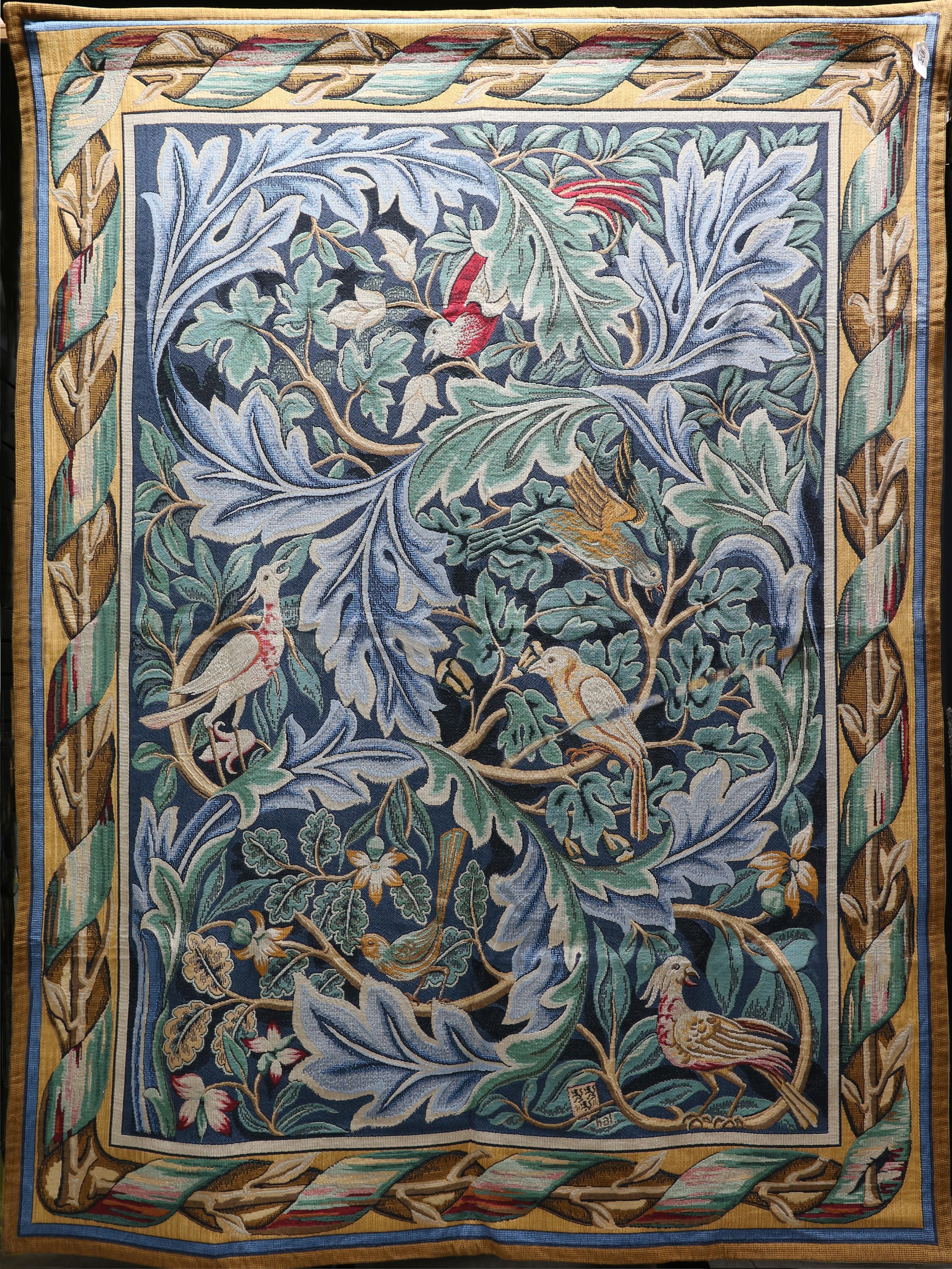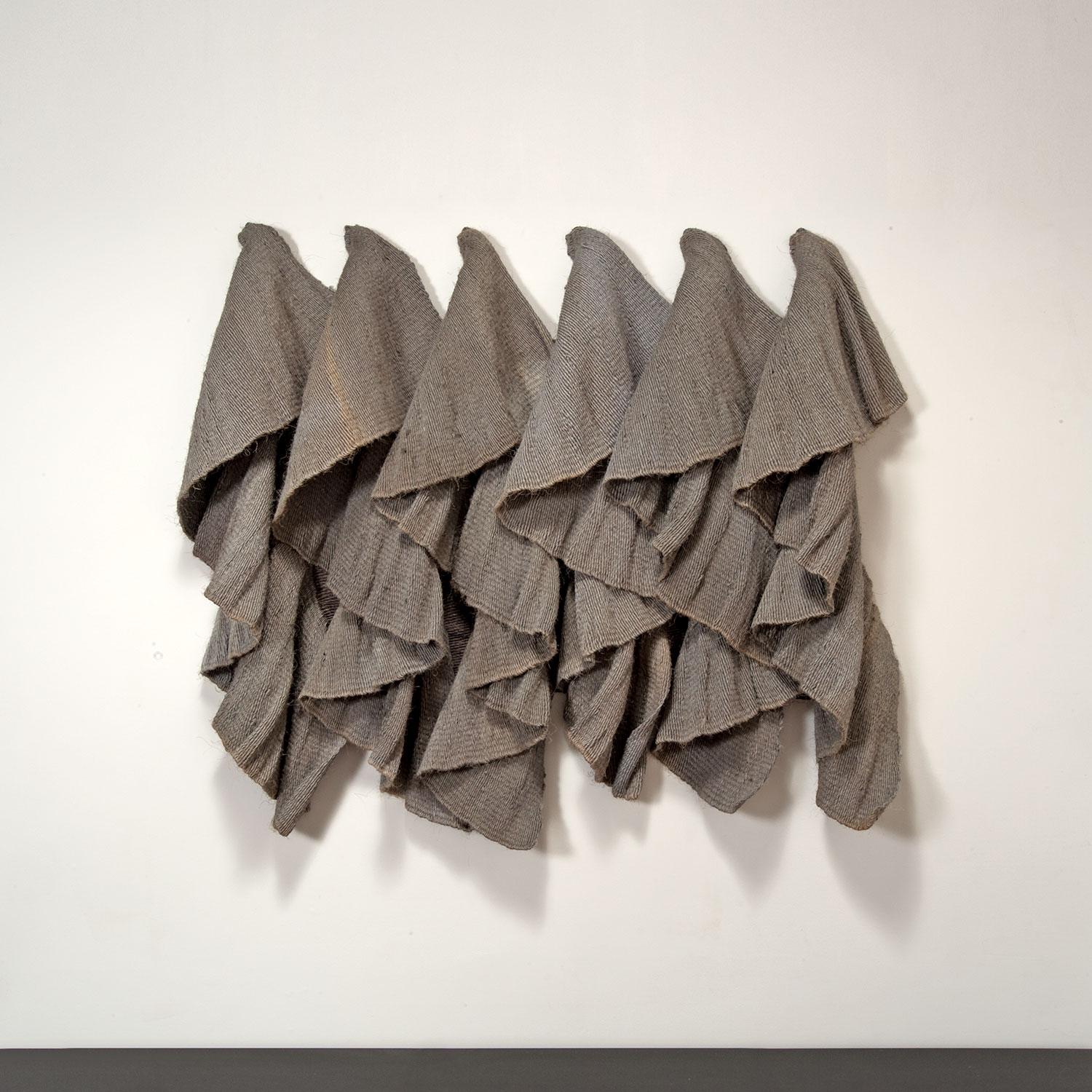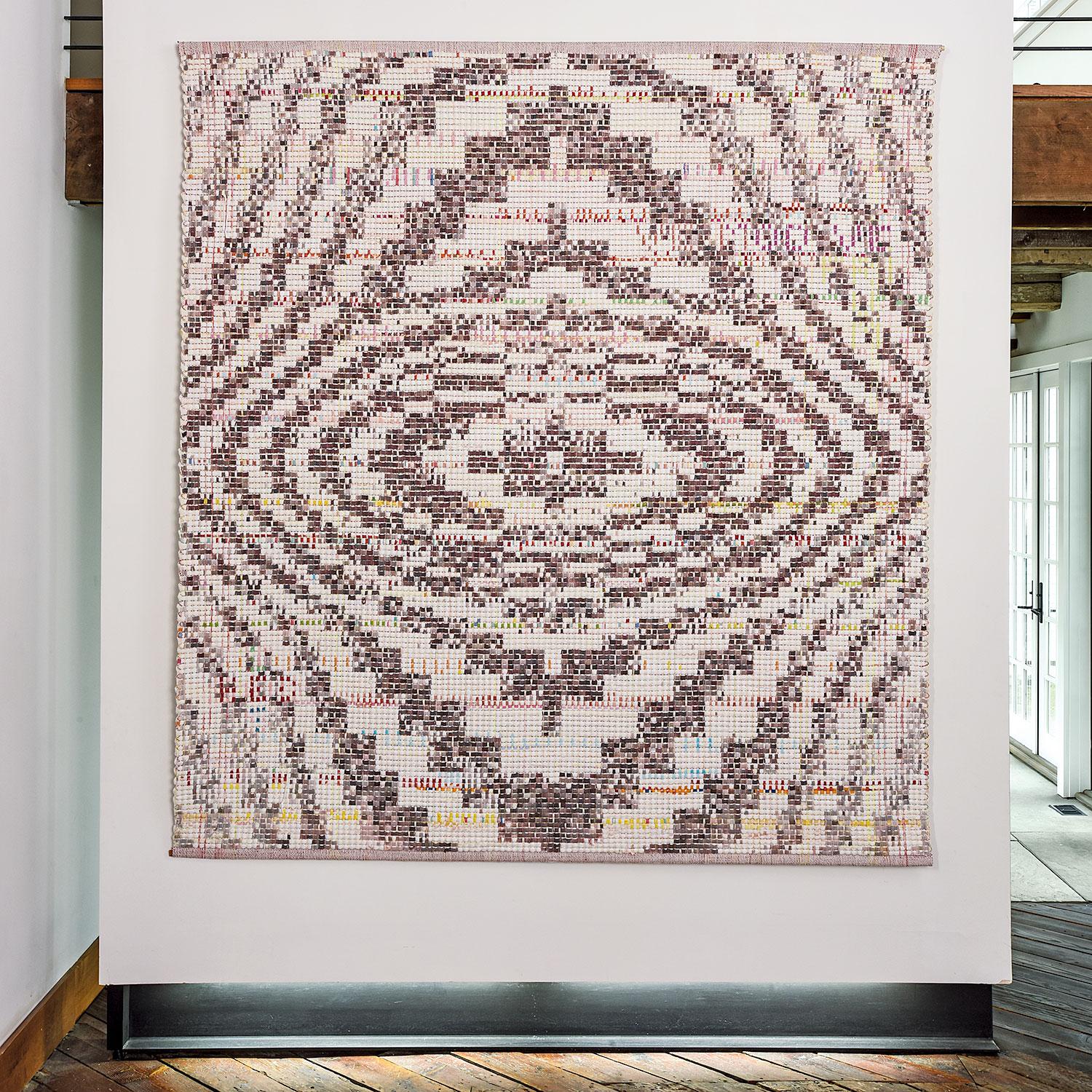Items Similar to The Academy of Plato, tapestry
Want more images or videos?
Request additional images or videos from the seller
UnknownThe Academy of Plato, tapestry1600s-1700s
1600s-1700s
About the Item
Small silk tapestry, with some applied inserts in painted canvas, corresponding to the faces and hands of the characters. The scene depicts Plato's Academy, with the philosopher sitting on the ground, his back against a tree, dressed in a cassock and a mantle that drapes him, with his right hand holding a tablet or parchment. He is intent on carrying out a philosophy lesson, with the young students who surround him and with one of whom he is speaking in particular. Behind a rural landscape inhabited by men who are doing agricultural work: some intent in sowing, some in harvesting and some, again, in cutting down a tree with an ax. In the background, to the right of the main group, a turreted construction can be seen, while to the left an ancient herm. Inserted in a coeval frame, molded in several orders with ebonized parts alternating with others veneered in tortoiseshell.
- Creation Year:1600s-1700s
- Dimensions:Height: 22.05 in (56 cm)Width: 25.6 in (65 cm)Depth: 2.37 in (6 cm)
- Medium:
- Period:Late 17th Century
- Condition:
- Gallery Location:Milan, IT
- Reference Number:1stDibs: LU680310469892
About the Seller
4.8
Gold Seller
These expertly vetted sellers are highly rated and consistently exceed customer expectations.
Established in 2017
1stDibs seller since 2017
102 sales on 1stDibs
Typical response time: 1 hour
- ShippingRetrieving quote...Ships From: Milan, Italy
- Return PolicyA return for this item may be initiated within 14 days of delivery.
More From This SellerView All
- Great Grass Juice 19th Century, The Nine MusesLocated in Milan, ITGrass juice. The word Euterp appears in the lower right corner. The huge grass juice depicts the nine Muses, Greek female deities, all sisters, as daughters of Zeus and Mnemosyne, an...Category
Late 19th Century Other Art Style More Art
MaterialsTapestry
- Paesaggio con Figure, 1700sBy Antonio Francesco Peruzzini 1Located in Milan, ITOlio su tela. La grande composizione propone un paesaggio che vede centrale un grande albero. a sormontare con le sue rade frasche la campagna sottostante, traversata da un corso d'acqua e animata da diverse figure di popolani intenti ad attività o a riposo; in alto a destra si erge una fortezza, che domina la vallata. Già attribuito al marchigiano Peruzzini, il dipinto si può ricondurre senz'altro al suo ambito, per i tratti pittorici veloci e poco aggregati. Antonio Francesco si specializzò nella pittura di paesaggio, subendo l'influenza di Salvator Rosa e di paesaggisti come Pietro Montanini...Category
18th Century Other Art Style Landscape Paintings
MaterialsOil, Canvas
- David and Abigail, fourth decade of the 17th centuryLocated in Milan, ITThe painting, done in oil on canvas, depicts the meeting between King David and Abigail, as narrated in the biblical text from the First Book of Samuel (I Samuel 25:1-34). David, left without food in the wilderness with his army, seeks relief from the wealthy Nabal, who contemptuously denies him any help, ungrateful of the benevolence he previously received from the king. Upon hearing the rejection, the ruler intends to take revenge by killing his entire lineage. Abigail, Nabal's beautiful and wise wife, decides to right the wrong and bring David plenty of food and gifts. In the king's presence the woman humbles herself, winning his forgiveness and benevolence. Soon afterwards widowed, she will in fact become his bride. The broad scene depicts the climax of the Old Testament episode, the moment when the woman prostrates herself before David and his servants prepare to deliver the gifts. The biblical event is here a pretext, as is customary in modern-age painting, for staging the colorful description of a sumptuous procession, which can be divided into two parts, almost two wings of a crowd divided specularly: on the left David with his dignitaries and the army; on the other, Abigail's retinue, handmaids, servants leading dromedaries and donkeys laden with food. The crowded group of figures is set in a natural proscenium: above a low horizon, barely hinted at by distant blue mountains, rises on the left side a craggy rocky cliff, the shelter of the army led by the ruler. The 'somatic intonation of the characters, as well as the choice of metallic chromatics and the play of light on the shiny fabrics refer to a clear Flemish matrix, particularly the influence of the frothy and sumptuous painting of Rubens and Van Dyck. As well set forth in the expert report prepared by Professor Giuseppe Sava, the work is to be attributed to Vincent Malò...Category
17th Century Other Art Style Figurative Paintings
MaterialsOil
- Madonna and Child with St. John, c. 1540-1560. Attributed to Carlo PortelliLocated in Milan, ITThe painting features Our Lady holding the Child, who extends his hand toward the wooden cross, the symbol of the future Passion, and St. John. Behind the three figures a rocky mount...Category
18th Century and Earlier Other Art Style Figurative Paintings
MaterialsOil
- Landscape with Architecture and Figures, Domenico Gargiulo attributed to, 1600sLocated in Milan, ITOil painting on canvas. The large landscape is dominated by an imposing architectural structure with columns overlooking the sea, which occupies the entire central part of the canvas...Category
17th Century Other Art Style Landscape Paintings
MaterialsOil
- The Preaching of St. John the Baptist, Workshop of Fans Francken II, 1600sLocated in Milan, ITThe sermon of the Baptist is set in a large open space, with rich vegetation and wooded glimpses, and on the back, in the distance, you can see the buildings of a city. The scene see...Category
17th Century Other Art Style Figurative Paintings
MaterialsOil
You May Also Like
- Porter Series: Carte L'Europe (Shower Woman)By William KentridgeLocated in Palm Desert, CA"Porter Series: Carte L'Europe (Shower Woman)" is a tapestry by South African artist William Kentridge. It is edition 1 of 5 (plus 2 APs) and signed verso "W. Kentridge". William Kentridge is a South African graphic artist, filmmaker, and theatre arts activist especially noted for a sequence of hand-drawn animated films he produced during the 1990s. The pungent humanism he revealed in these and other works echoed a larger European tradition of artists such as Honoré Daumier, Francisco de Goya, and William Hogarth. Kentridge, whose father was a noted antiapartheid lawyer, attended the University of Witwatersrand in Johannesburg (1973–76) and the now-defunct Johannesburg Art Foundation (1976–78). At various times in the 1970s and ’80s, he worked as an actor, playwright, set designer, and theatrical director, and he studied mime and theatre in Paris in the early 1980s. In 1992 he began an ongoing collaboration involving multimedia performances with Handspring Puppet Theatre (founded 1981) in Cape Town. As is clear from both his early training and his later artistic output, Kentridge’s interest in the visual arts was rooted in its connection with the theatrical arts. The narrative structure and character development in his films reflect this connection. While Kentridge pursued several avenues as an artist, at the centre of his work was a sequence of short animated films. To produce them, he made a rough charcoal drawing, photographed it, altered the drawing slightly, photographed it again, and so on. Kentridge’s original drawings are often completely effaced by their successors. Many of these films—including Johannesburg, 2nd Greatest City After Paris (1989) and Felix in Exile (1994)—follow the fortunes of the greedy capitalist Soho Eckstein and his alter ego, the sensitive and artistic Felix Teitelbaum. They present modern South Africa as reflective of the spiritual, ecological, and emotional crises of late capitalism. Kentridge later established himself as a consummate figure in the performing arts, particularly for his innovative stagings of the operas The Nose (2010) and Lulu (2015) at New York’s Metropolitan Opera and Wozzeck (2017) at the Salzburg Festival...Category
21st Century and Contemporary More Art
MaterialsTapestry, Silk
- Les Oiseaux (The Birds)Located in Atlanta, GAThis tapestry is based on a design by William Morris (1834-1896). He was instrumental in the revival of the decorative arts at the end of the 19th century. This tapestry is French ...Category
Late 20th Century Naturalistic More Art
MaterialsTapestry
- Who Knows One (Passover), Large Tapestry Rug by Shlomo KatzBy Shlomo KatzLocated in Long Island City, NYArtist: after Shlomo Katz, Polish/Israeli (1937 - 1992) Title: Who Knows One (Passover) Year: 2000 Medium: Woolen Carpet Tapestry, signature in the cache Size: 120 x 95 in. (304.8 x ...Category
Early 2000s Expressionist More Art
MaterialsTapestry, Wool
- Summer and Winter, Mid-Century Tapestry, Woven Hanging, Textile Wall SculptureBy Adela AkersLocated in Wilton, CTAdela Akers (b. 1933, Santiago de Compostela, Spain) is a Spanish-born textile and fiber artist. She is Professor Emeritus (1972 to 1995) at the Tyler Scho...Category
1970s Abstract Abstract Sculptures
MaterialsTextile, Linen, Thread, Yarn, Fabric, Tapestry
- State of Mind, Contemporary Woven Tapestry, Geometric Abstract Textile SculptureBy Ane HenriksenLocated in Wilton, CTState of Mind, Contemporary Woven Tapestry, Abstract Textile Wall Sculpture, Viscosed silk, cotton cloth, jersey dots, 102” x 95”, 2016 by textile artist, Ane Henriksen...Category
2010s Abstract Geometric Abstract Sculptures
MaterialsFabric, Textile, Tapestry, Cotton, Silk
- Silver Marilyn, Andy Warhol, 1990's, Handmade Carpet, Pop ArtBy Andy WarholLocated in Zug, CHAndy Warhol (after) Silver Marilyn, 1990s Handmade Carpet 150 × 150 cm (59.1 × 59.1 in) Certificate of authenticity on label Edition of 20 In excellent condition Published by Modern Master Tapestries, NY The artwork is offered unframed As a golden legend of Hollywood, Marilyn Monroe held particular fascination for Andy Warhol. Her suicide on August 5, 1962 struck a personal chord and precipitated a commemorative series that isolated her beautiful and henceforth elusive visage against variously colored backdrops. In the increasingly secular 1960s, Warhol was quick to recognize that movie stars had replaced the religious figures of his childhood, as the idols which the population at large chose to worship. Andy Wahrol worked with tapestry in his life as works were presented by Charles Slatkin...Category
1990s Pop Art More Art
MaterialsTapestry




